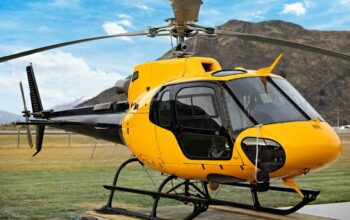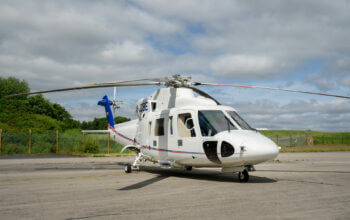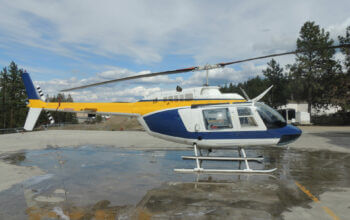The chief pilot of the Los Angeles Police Department Air Support Division (LAPD ASD) says the unit has taken steps to address some key recommendations contained in a highly critical program audit released in December 2023.
Performed by the office of LA City Controller Kenneth Mejia, the audit raised a number of questions about LAPD ASD. It is the largest municipal airborne law enforcement operation in the world, with 17 helicopters in the fleet — two of which are nearly always in the air, flying air support to regulator operations (ASTRO) missions. On average, the response time of an LAPD helicopter ranges from seconds up to two minutes.
While this was the first time ASD has been audited by the city controller, the unit has undergone regular reviews performed by independent aviation safety consultants, as well as the LAPD’s own audit division.
Among other criticisms, the controller’s office found that the helicopter program — which costs the city almost $50 million per year — engaged in a high proportion (61 percent) of flights for incidents that were not considered priorities, including transportation, patrol, and ceremonial flights.
The report said some were an inappropriate use of city funds, including “passenger shuttle flights for a Chili Fly-In.” The auditors questioned whether helicopter patrols actually deter crime, and pointed to environmental and noise pollution associated with police aircraft.

The audit also highlighted perceived deficiencies in flight data collection and monitoring, including ASD’s current method of tracking the particulars of each flight.
In short, the report made a series of recommendations to reduce inefficiencies, improve data collection and management, and boost transparency and performance monitoring.
LAPD responds
Two months later, the LAPD released its official response to the city controller’s audit.
While the police department agreed there are opportunities to improve ASD data collection and enhance public understanding of the unit and its work, it also identified a list of concerns with the way the audit was conducted.
From questioning the auditing standards, to pointing out factual errors and an inability to replicate and validate the information, LAPD defended its ASD, saying the audit neglected to consider the intangible contribution helicopters make to officer and public safety.
For Kevin Gallagher, LAPD ASD chief pilot, there’s no question about the aviation unit’s value. He has worked at the ASD for 24 years, and he said helicopters are a force multiplier.
“One helicopter can handle what four or five patrol units can handle, depending on what it is,” he told Vertical. “The police department considers these helicopters to be patrol cars in the sky. Our mission is the same; only the vehicle has changed. If you’ve ever seen pictures of our helicopters, they are painted black and white, the same as patrol cars.”
Gallagher said the crews in the helicopters are all former street cops, selected for their experience in the field. In a tense situation when lives are on the line, that experience is a lifeline for officers on the ground — particularly since Los Angeles is currently fielding a fairly young police force.
“The ASD gets to the scene first most of the time,” he explained. “When they get there, they can provide an aerial perspective. They can see how an incident is unfolding better from the air than the ground. Units responding on the ground can’t see into a backyard or over a fence, for example. Air officers provide that info to ground officers before they respond, so they know what they are getting into. The most valuable resource for those officers is the experience base of the crew flying above them — [air officers] can provide tactical insights and experience [ground officers] don’t have.”
Aside from increasing officer safety, a police helicopter can also call in additional units or cancel them, as required.

Gallagher explained that as chief pilot of the ASD, it’s his job to address any issues relating to the unit’s flight operations or pilot performance.
“My position comes in after the audit; if something comes out of the audit that the air unit needs to address, I will be directed to make those changes and improvements — for anything related to flight operations.”
One such area was the city controller’s point that flight data collection and storage must be improved. Gallagher concedes it’s an issue that surprises no one in ASD.
“An area we are working to improve on at the division that was presented in the controller’s report is how we capture the data from our patrol flights,” he said. “We are looking to find a software system or a company that will allow our data capture to be better than the current system. We’ve made requests in the past for more sophisticated systems, but because they cost money they’ve always been denied.”
Gallagher explained the ASD used to record flight operations data through a Microsoft program that has been discontinued. Now, each flight is recorded on a system provided free of charge by a vendor that assists the ASD with its navigation systems. It’s not perfect, he admitted.
“It currently records when the helicopter gets the call, what type of call it is, the geographic area, time of day, etc.,” he said. “One of the parts in the audit that came up was the over-use of the ‘miscellaneous’ box. There are so many different categories for each flight, so a lot ends up in miscellaneous. We need to define miscellaneous better. We would agree with that. It’s difficult to capture or categorize everything you encounter when handling a police incident. Some things are just things you’ve never seen before.”
Simply put, a more robust recording system will come at a cost, Gallagher said.
“We don’t have funding for a better system now — and if we don’t get funding, we’ll continue to use the current system.”

In addition to how flight data is recorded, the controller pointed to issues with where it is being stored. Currently, Gallagher said that data is stored on the outside vendor’s cloud.
“One question asked is whether the city should be capturing that data and storing it somewhere more secure. We would like to do that, but the system doesn’t exist on our current department internet and land system. It would have to be custom-made. There is currently no option to do it internally.”
Again, Gallagher said this isn’t a new issue and that the department is always trying to find the best way to capture flight data.
“It’s useful to the police department in quarterly crime meetings,” he pointed out.
As for how the audit was performed, Gallagher said the city controller’s team did not fly along with ASD nor “shadow” the unit at work, despite being invited to do so.
“They came to Air Support Division and met with the commanding officer and were given access to whatever they wanted,” Gallagher said. “We provided them with all the documentation, all the actual costs of everything that we had access to. They were invited to come and do a ride-along when their audit process started, probably a year before the audit report was released. They were invited to shadow ASD then and were given access to all documentation and actual costs of everything we had.”
Gallagher also refutes the claim that 61 percent of ASD flights are flown for non-high priority events.
“If you look at it, they use Part 1 crimes to quantify these non-high priority flights. But that Part 1 classification is assigned after the crime is concluded, as per FBI protocol,” he said. “When a 911 operator puts out a call for service, the crime is still unknown and unclassified. They continue to reference Part 1 crimes — which include homicides, robberies and property crimes such as auto theft — that aren’t even a classification when initially responding to crimes.”
Gallagher also took issue with the reference to flights associated with the LAPD “Chili Fly-In” as being an “inappropriate use of city funds.” He explained that the Chili Fly-In is an informal nickname referring to an annual multi-agency disaster preparedness exercise, “where we mobilize all airborne assets in the region to coordinate the movement of people.”
He said the “passengers” referenced in the auditor’s report are regional air traffic controllers who are flown into the LAPD’s Hooper Heliport to plan for a mass evacuation scenario involving coordinated lift capability — including a terrorist incident, mass casualties, an earthquake, or a plane crash. Rather than being a liability, the exercise is an investment in preparedness, Gallagher said.
When referring to the LA City Controller’s audit, LAPD maintains: “The Department’s opinion is the report is flawed and, in many instances inaccurate, and provides minimal value in the Department’s pursuit of continuous improvement.”
For Gallagher, an experienced police officer, the ASD’s value is clear.
“We can’t capture data on incidents where officers didn’t get hurt — we can’t tell you how many officers in pursuit didn’t crash as they approached an intersection, thanks to the ASD. That’s why we’re out there and that’s why the police department defends how the unit operates,” he concluded.









